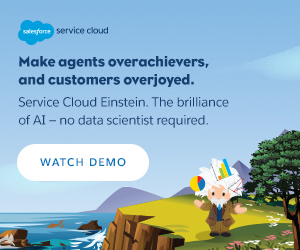This content was produced for Salesforce by the foundry @ MEREDITH CORP. FORTUNETM editorial staff was not involved in its creation or production.
Hype would have it that new technology is putting everyone out of work. But is this actually true? While old roles in some fields are dying (when was the last time you needed a typewriter repair shop?), experience tells us that such fears—though natural—aren’t always justified. Throughout history, advances in machines and systems have continuously transformed the way we function for the better. They’ve relieved us of the drudgery of rote tasks to take on challenges that keep us fully engaged. They’ve freed our minds to invent, innovate, and look to the future.
That’s especially true as we approach the third decade of the 21st century. With new tools in hand, today’s workforce is smarter and more efficient. And in an era when customer experience can make or break an enterprise, businesses are embracing any opportunity for customer-facing improvements.
Still, the contrast between the scary job-loss scenario and the technology-is-your-friend one is particularly evident in the contact center. And a major source of agent concern is the chatbot, which simulates human interactions. As a consumer, no doubt you’ve seen them pop up on your monitor when you’re contemplating a purchase or have a question to ask.
The basic technology has been around for years, but recent developments in AI and natural language understanding mean that now they have capabilities that weren’t possible just a couple of years ago. Today, they can seamlessly gather chatter from every channel your customers use, quickly turn it into reports, and give your organization a remarkable, in-the-moment view of your marketplace. In this way, using predictive analytics, bots help drive decisions that have a real bottom-line impact, especially in the moving-target atmosphere of modern, nimble businesses. What’s more, bot enablers, such as Salesforce’s Einstein platform and out-of-the-box applications, adapt to—and integrate with—contact center needs with remarkable ease.
Ample research already indicates that customers love using bots. As one-stop resources, they reduce waiting time and other delays preventing them from getting the information they need. So it’s no wonder some agents regard chatbots as invaders, poised to take over and make them redundant. Their thinking: With all these bells and whistles and when customers can have their issues and requests handled by a computer, why bother having agents at all?
The concern is human. But the facts on the ground are much more encouraging. Experts in contact center management have noted the real benefits agents experience when bots handle humdrum tasks and questions. In the past, agents spent a lot of time entering—and often reentering—customer information, for example. And when they weren’t doing that, they were responding to repetitive questions (and about 80% of them are repetitive) from callers, emailers, or texters. No wonder attrition rates among agents have traditionally been high. Worse, the ones who stayed on the job had no outlet for initiative.
 Photo: Getty Images
Photo: Getty Images
That’s changing. Bots can now relieve agents of those chores, freeing them to pursue higher ground when it comes to customer care—and that’s a paradigm shift from the routine. Because bots accumulate a rich lode of customer information, agents can tap into this data to get context about customers and to unearth well-rounded insights about their needs and desires. That means they can offer highly personalized responses to queries and make recommendations based on customers’ previous actions. When agents have this intelligence in hand, it unleashes opportunities for customer loyalty-building, upselling, and cross-selling. And it gives those agents pride of purpose.
The pride has a real ripple effect too. In previous eras, disengaged contact center agents took a toll on business. By some estimates, the poor service that was the outcome of the perfunctory tasks they performed—reading scripts and doing the minimum—lost companies up to 20% of their customers every year. Agent turnover was a significant issue as well, costing enterprises in terms of restaffing and retraining.
There’s another point to make here. Liberating the 21st-century agent to sell has been an interesting side effect of bots. Evolving businesses understand the value of breaking down functional silos. But jobs can be siloed too. Bots are helping sales, service, and product experts operate as one, because by using them, all parties can access, share, and produce critical information. The result? Divisions between the front and back offices begin to crumble and the enterprise works together as a truly harmonized unit.
In other words, when used properly, chatbots are helpful, empowering assistants and workers. They free them up from boring jobs and elevate them to true partners in the enterprise who can address complex issues.
“Salesforce believes fundamentally that bots are going to be complementing your live staff,” Meredith Flynn-Ripley, vice president of digital engagement and mobile messaging at Salesforce, recently told Business Insider. “We really see bots as changing the job description and turning agents into intelligent problem solvers.”
In other words, the agent’s job isn’t going anywhere but up.







